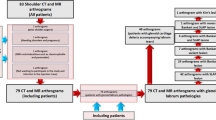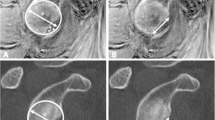Abstract
Objectives
To determine the diagnostic accuracy of non-arthrographic MR imaging, conventional MR arthrography, and 3D T1-weighted volumetric interpolated breath-hold examination (VIBE) MR arthrography sequences as compared with a CT arthrography in the diagnosis of glenoid bare spot.
Methods
A retrospective study of 216 patients who underwent non-arthrographic MR imaging, conventional MR arthrography, VIBE MRI arthrography, and CT arthrogram between January 2011 and March 2022 was conducted. The diagnostic accuracy of non-arthrographic MR imaging, direct MR arthrography, and VIBE MRI arthrography in the detection of glenoid bare spot was compared with that of CT arthrography. All studies were reviewed by 2 MSK radiologists. Interobserver agreement for MR imaging and MR arthrographic findings was calculated.
Results
Sixteen of 216 patients were excluded. Twenty-three of 200 shoulders had glenoid bare spot on CT arthrographic images. The glenoid bare spot was detected in 11 (47.8%) and 7 (30.4%) patients on conventional non-arthrographic MR images and in 18 (78.3%) and 16 (69.6%) patients on conventional MR arthrograms by observers 1 and 2, respectively. Both observers separately described the bare spot in 22 of 23 patients (95.7%) on 3D volumetric MR arthrograms. Interobserver variabilities were fair agreement for conventional non-arthrographic MR imaging (κ = 0.35, p < 0.05), moderate agreement for conventional MR arthrogram (κ = 0.50, p < 0.05), and near-perfect agreement for 3D volumetric MR arthrogram reading (κ = 0.87, p < 0.05).
Conclusions
A 3D high-resolution T1-weighted VIBE MR arthrography sequence may yield diagnostic performance that is comparable with that of CT arthrography in the diagnosis of glenoid bare spot.
Key Points
•Glenoid bare spot should not be misdiagnosed as a transchondral defect of the glenoid surface by radiologists.
•A 3D high-resolution T1-weighted VIBE MR arthrography sequence may be used as a high-sensitivity imaging technique in the diagnosis of glenoid bare spot.





Similar content being viewed by others
Abbreviations
- 3D:
-
Three-dimensional
- CT:
-
Computed tomography
- MR:
-
Magnetic resonance
- VIBE:
-
Volumetric interpolated breath-hold examination
References
Dunham KS, Bencardino JT, Rokito AS (2012) Anatomic variants and pitfalls of the labrum, glenoid cartilage, and glenohumeral ligaments. Magn Reson Imaging Clin N Am 20:213–228
Burkhart SS, Debeer JF, Tehrany AM, Parten PM (2002) Quantifying glenoid bone loss arthroscopically in shoulder instability. Arthroscopy 18(5):488–491
Kralinger F, Aigner F, Longato S, Rieger M, Wambacher M (2006) Is the bare spot a consistent landmark for shoulder arthroscopy? A study of 20 embalmed glenoids with 3-dimensional computed tomographic reconstruction. Arthroscopy 22:428–432
Chuang TY, Adams CR, Burkhart SS (2008) Use of preoperative three-dimensional computed tomography to quantify glenoid bone loss in shoulder instability. Arthroscopy 24:376–382
McCarty LP 3rd, Cole BJ (2005) Nonarthroplasty treatment of glenohumeral cartilage lesions. Arthroscopy 21:1131–1142
Graichen H, Jakob J, von Eisenhart-Rothe R, Englmeier KH, Reiser M, Eckstein F (2003) Validation of cartilage volume and thickness measurements in the human shoulder with quantitative magnetic resonance imaging. Osteoarthritis Cartilage 11:475–482
Ogul H, Taydas O, Sakci Z, Altinsoy HB, Kantarci M (2021) Posterior shoulder labrocapsular structures in all aspects; 3D volumetric MR arthrography study. Br J Radiol 94:20201230
Ogul H, Tas N, Tuncer K et al (2019) 3D volumetric MR arthrographic assessment of shoulder joint capacity in patients with primary adhesive capsulitis. Br J Radiol 92:20180496
Ogul H, Karaca L, Can CE et al (2014) Anatomy, variants, and pathologies of the superior glenohumeral ligament: magnetic resonance imaging with three-dimensional volumetric interpolated breath-hold examination sequence and conventional magnetic resonance arthrography. Korean J Radiol 15:508–522
Yu JS, Greenway G, Resnick D (1998) Osteochondral defect of the glenoid fossa: cross-sectional imaging features. Radiology 206:35–40
Ramos MRF, Hidalgo PF, Fagundes D, San YAC (2020) Bare spot location in glenoid cavity: comparison between arthroscopy and CT scan. Acta Ortop Bras 28:243–246
Ly JQ, Bui-Mansfield LT, Kline MJ, DeBerardino TM, Taylor DC (2004) Bare area of the glenoid: magnetic resonance appearance with arthroscopic correlation. J Comput Assist Tomogr 28:229–232
Aigner F, Longato S, Fritsch H, Kralinger F (2004) Anatomical considerations regarding the “bare spot” of the glenoid cavity. Surg Radiol Anat 26(4):308–311
Kho J, Kholinne E, Lim S et al (2019) Arthroscopic bare spot method underestimates true bone defect in bony Bankart lesion. Arch Orthop Trauma Surg 139:1269–1275
Kim HK, Emery KH, Salisbury SR (2010) Bare spot of the glenoid fossa in children: incidence and MRI features. Pediatr Radiol 40:1190–1196
Djebbar S, Rosenberg ZS, Fitzgerald Alaia E, Agten C, Zember J, Rossi I (2018) Imaging features of glenoid bare spot in a pediatric population. Skeletal Radiol 47:45–50
Resnick D, Kang HS (2007) Shoulder. In: Resnick D, Kang HS (eds) Internal derangements of joints, 2nd edn. Saunders, Philadelphia, pp 713–1122
Kim HK (2009) Bare spot: a normal variant on shoulder MR arthrography. Pediatr Radiol 39:1124
Alashkham A, Alraddadi A, Soames R (2017) Bare spot and tubercle of Assaki. JSES Open Access 1:141–143
De Maeseneer M, Pouliart N, Boulet C et al (2012) A bare area of the glenoid misdiagnosed as a cartilage ulceration. JBR-BTR 95:22–24
Warner JJ, Bowen MK, Deng XH, Hannafin JA, Arnoczky SP, Warren RF (1998) Articular contact patterns of the normal glenohumeral joint. J Shoulder Elbow Surg 7:381–388
Jung HG, Kim NR, Jeon JY et al (2018) CT arthrography visualizes tissue growth of osteochondral defects of the talus after microfracture. Knee Surg Sports Traumatol Arthrosc 26:2123–2130
Funding
The authors state that this work has not received any funding.
Author information
Authors and Affiliations
Corresponding author
Ethics declarations
Guarantor
The scientific guarantor of this publication is Hayri Ogul.
Conflict of interest
The authors of this manuscript declare no relationships with any companies whose products or services may be related to the subject matter of the article.
Statistics and biometry
No complex statistical methods were necessary for this paper.
Informed consent
Written informed consent was obtained from all subjects (patients) in this study.
Ethical approval
Institutional Review Board approval was obtained.
Methodology
•retrospective
•cross-sectional
•performed at one institution
Additional information
Publisher's Note
Springer Nature remains neutral with regard to jurisdictional claims in published maps and institutional affiliations.
Rights and permissions
Springer Nature or its licensor (e.g. a society or other partner) holds exclusive rights to this article under a publishing agreement with the author(s) or other rightsholder(s); author self-archiving of the accepted manuscript version of this article is solely governed by the terms of such publishing agreement and applicable law.
About this article
Cite this article
Ozel, M.A., Ogul, H., Koksal, A. et al. Detection of the glenoid bare spot by non-arthrographic MR imaging, conventional MR arthrography, and 3D high-resolution T1-weighted VIBE MR arthrography: comparison with CT arthrography. Eur Radiol 33, 3276–3285 (2023). https://doi.org/10.1007/s00330-023-09443-0
Received:
Revised:
Accepted:
Published:
Issue Date:
DOI: https://doi.org/10.1007/s00330-023-09443-0




